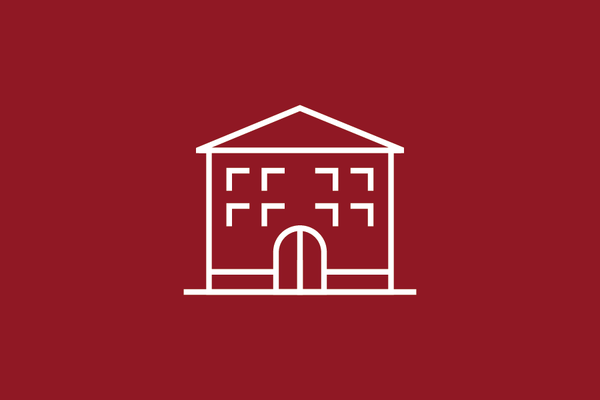Pushing the boundaries
At Indian Health Service, four nurse-midwifery alumni thrive
March 26, 2020
Brett Stursa

Above: Anjali Madeira, right, makes rounds on mom Erika Tippin, a few days after her son Suluk was born, with papa Andrew Oktollik looking on. The family is from Point Hope, Alaska, a village of about 700 people on the Chukchi Sea north of the Arctic Circle.
Jessica Thienes, DNP ‘18, APRN, CNM, doesn’t assume her patients go home to running water or electricity.
As a nurse-midwife at the Gallup Indian Medical Center (GIMC) in New Mexico, many of the women she sees live without those conveniences.
“It affects how you provide care,” said Thienes. “In the Twin Cities, I would just encourage all my patients to take warm baths to soothe their aching, pregnant muscles. But here, if a woman doesn’t have running water, then I move to other things, like ice or heat packs, a massage or Tylenol. Before I make a recommendation, I have to keep in mind if it is a resource that’s accessible.”
Thienes says her practice at GIMC, which sits on the edge of the Navajo Nation reservation two hours west of Albuquerque, is challenging and can be exhausting, but is also rewarding and a privilege to provide.

“I think getting to be there for such a significant and intimate moment in a family’s life is such an honor,” said Thienes. “We’re not hyper-focused on dealing with some of the abnormalities of births. I really get to know a woman and be there for whatever that means for her. It’s establishing that relationship and I think that’s one of the best things about our profession.”
Thienes is one of four nurse-midwives who graduated in 2018 from the University of Minnesota Doctor of Nursing Practice program’s specialty in nurse-midwifery who now practices with Indian Health Service. While Thienes practices at GIMC with Anna Jacobsen, Anjali Madeira and Jennifer Godbold practice at the Southcentral Foundation Alaska Native Medical Center. The alumni say being a nurse-midwife at Indian Health Service challenges them to practice at the highest levels of their scope of practice, with the support of interprofessional teams that excel at providing evidence-based care.
Nurse-midwifery as a standard of care
In both the New Mexico and Alaska practices, nurse-midwifery is the standard of care for pregnancy. “Our practice model allows us to provide hands-on care for all vaginal deliveries with collaboration and consultation if the need arises. This model gives our patients the benefits of midwifery care with the expertise of the OB/GYN physicians as needed,” said Jacobsen, DNP ‘18, APRN, CNM.
This model is not standard midwifery practice throughout the United States. In this model, nurse-midwives manage care for women with complex needs like an anxiety disorder or gestational diabetes, which effects 30% of their patients in New Mexico.
“It’s really accepting that childbirth is pretty normal and even for women with complications that midwives can co-manage with a physician and provide that care safely,” said Thienes. “We practice at the top of our scope. Physicians practice at the top of their scope. Everyone is pretty well utilized.”
In Anchorage, Madeira, DNP ‘18, MPH, APRN, CNM, sees Alaska Native women from rural villages whose care was transferred to her team because they developed complications or have complex needs, like gestational hypertension or a history of a postpartum hemorrhage.
Generally, women are transferred to Anchorage about a month before their due date. Once a mom is transferred, with rare exception, she is there until she delivers, living onsite, in hotel-style accommodations with up to three family members.
“Because we are caring for such high-risk women, it is not a traditional midwife practice,” said Madeira. “We’re practicing within our scope of care but it’s at the very highest level.”
There are still many aspects of traditional nurse-midwifery care that the alumni say they carry into their practice. “I love answering questions, providing education and being by their side throughout their journey,” said Godbold, DNP ‘18, APRN, CNM, who practices in a primary care setting in Wasilla. “For me, it was really important to practice within the Indigenous community. It’s through my learning of my own family history and learning from my grandparents, mom and community members that I’ve come to understand the importance of me being a part of the community.”
At the center of their practice is building relationships with women to be able to provide personalized care. For Madeira, her ability to build those relationships is made easier with 30 minutes for prenatal visits, double the time many providers around the country are permitted. “In a 15 minute return prenatal visit, I talk about all of the critical things. But with that extra 15 minutes, I get to delve so much deeper and it improves the care quality and our relationship so much,” she said.
A collaborative practice
The nurse-midwives say the collaborative practice model they have with obstetricians is critical. While obstetricians are required for cesareans or a vacuum extraction, they also are available for consult or a second opinion. “I think one of the best parts of practicing here is the practice model,” said Jacobsen. “It’s incredibly supportive. Midwives can practice at the very top of their scope but also feel well supported.”
In New Mexico, the nurse-midwives and obstetricians hold bi-weekly meetings to discuss high-risk patients and regular meetings are scheduled involving social workers, diabetes educators, clinical nursing staff, pediatricians, infectious disease physicians and public health nursing. “All of those specialties play a really critical role in caring for our patients. Having a team-based model is extremely important for our patients to get the care that they need,” said Thienes.
Both Thienes and Jacobsen say they felt prepared for collaboration after their experience at the School of Nursing, where they both attended the Master of Nursing and Doctor of Nursing Practice programs. “There was a big push for interprofessional collaboration,” said Jacobsen. “From the different simulations that we participated in with OB-GYN residents to our clinical sites where we would engage in interprofessional rounds, it was clear that interprofessional collaboration was a critical element
to communication and optimizing patient outcomes.”
It’s a model that Madeira and Godbold say they experience in Alaska. “The care model is one of the reasons why I came here. It is a collaborative team of physicians, nurse-midwives and nurses, and we offer integrative services such as a dietician, lactation, behavioral health, complementary medicine, exercise education and traditional healing. We practice in a holistic way by providing resources and care for the whole person,” said Godbold
Evidence-based care and quality improvements
Quality improvement is a key component to their practices and the education they received about evidence-based practice prepared them well.
While Jacobsen is part of an interprofessional team that runs quarterly drills involving obstetrical emergencies, like postpartum hemorrhage or breech delivery, Thienes leads a quarterly journal review to discuss the most recent literature, which leads to updated or new policy. A recent review focused on failed inductions, which lead to cesareans. “About 40 percent of our patients are induced, so we really took a deep dive into the evidence to see what criteria need to be met and what protocol should be in place to make sure that we’re reviewing all those things for our patient before we recommend a C-section,” said Thienes. “We’re pretty comfortable reviewing articles and critically thinking about the evidence. I think the University of Minnesota prepared us really well.”

Godbold is a member of a Plan Do Study Act team looking at two-week postpartum visits, while Madeira is on the quality assessment committee. “It’s a very active committee of obstetricians and nurse-midwives that keeps my focus on evidence-based care and on quality improvement,” said Madeira.
The committee recently reviewed shoulder dystocia, which is a significant obstetric complication when the baby’s head is born but the shoulders become impacted against the pelvis and require special maneuvers to deliver the baby. If the baby is not delivered within 5 minutes, permanent brain damage or death often results. “It is something that we see at a much higher rate here because we have a higher rate of gestational diabetes and moms with higher BMIs, both risk factors for shoulder dystocia. It’s not unusual for us to have a mom with a BMI in the 40s and sometimes in the 60s, so we have a lot of risk factors within our demographic,” said Madeira. “Shoulder dystocia happens more often in our practice and we work really hard on managing it as a team. I think we’re really good at it, but you can always get better.”
At the core of Madeira’s growth as a nurse-midwife are the women who come to her for care. “Our moms are tough as nails, and this has been an incredibly special community to work with,” said Madeira. “They have taught me a lot about grace, resilience and what it looks like to blend culture and tradition with evidence-based care. I know that there’s so much more to learn from them.”


